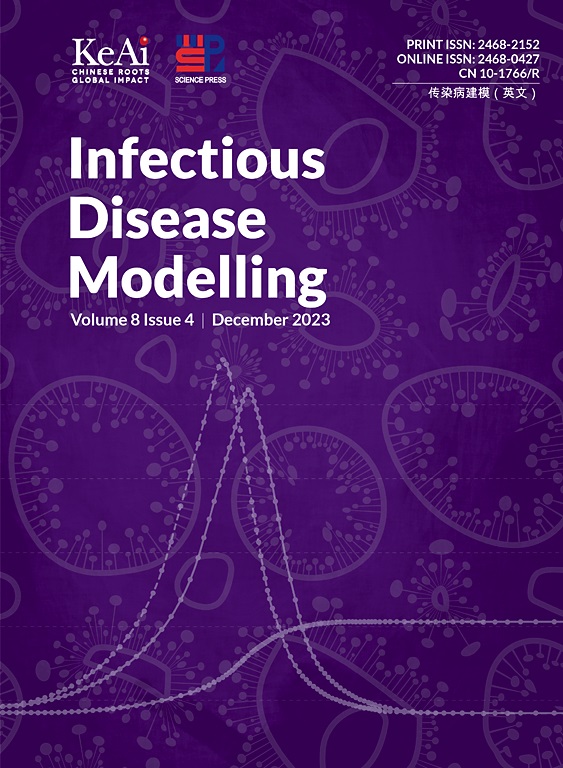Diphtheria transmission dynamics – Unveiling generation time and reproduction numbers from the 2022–2023 outbreak in Kano state, Nigeria
IF 2.5
3区 医学
Q1 Medicine
引用次数: 0
Abstract
Background
Diphtheria, caused by Corynebacterium diphtheriae, remains a serious public health threat in areas with low vaccination coverage, despite global declines due to widespread immunization and improved clinical management. A major outbreak in Nigeria from 2022 to 2023 underscored the persistent risk in regions with inadequate vaccination. This study aims to assess the transmission dynamics of diphtheria in Kano State, the epicenter of the outbreak, by estimating key epidemiological parameters, including the generation time (GT), approximated in our study by serial interval, and effective reproduction number (Rₜ).
Methods
We analyzed diphtheria case-based data from Kano State, Nigeria, collected between August 18, 2022, and November 29, 2023. Generation time was approximated using serial intervals in confirmed cases within the same geographical areas. The effective reproduction number (Rₜ) was calculated using four methods: Maximum Likelihood Estimation (MLE), Exponential Growth (EG), Sequential Bayesian (SB), and Time-Dependent (TD), focusing on the period of maximum exponential growth. A sensitivity analysis was conducted to quantify the impact of uncertainties in the GT derived from our data on the estimation of Rₜ.
Results
Over the 469-day outbreak period, 13,899 diphtheria cases were reported, with complete data available for 9406 cases. The estimated mean generation time was 2.8 days (SD = 3.48 days), with 97% of cases having a GT of less than 21 days. The Rₜ estimates varied across methods, with the TD method producing the highest reproduction number of 2.21 during the peak growth period. Sensitivity analysis showed that Rₜ estimates increased with longer generation times. The models, except for the SB method, demonstrated a generally strong fit with the outbreak exponential growth period.
Conclusion
The ongoing diphtheria outbreak in Nigeria highlights the critical threat posed by declining vaccination coverage. This study provides valuable insights into the transmission dynamics of diphtheria during a prolonged and widespread outbreak, enhancing our understanding of disease spread in this context. While certain limitations may influence the interpretation of our estimates, the findings offer valuable information for future diphtheria outbreak preparedness and response in the African context.
白喉传播动态——揭示尼日利亚卡诺州2022-2023年暴发的世代时间和繁殖数量
背景:在疫苗接种覆盖率低的地区,由白喉棒状杆菌引起的白喉仍然是一个严重的公共卫生威胁,尽管由于广泛的免疫接种和临床管理的改善,全球白喉发病率有所下降。2022年至2023年在尼日利亚爆发的一场重大疫情凸显了疫苗接种不足地区的持续风险。本研究旨在通过估计主要流行病学参数,包括本研究中通过序列间隔估算的产生时间(GT)和有效繁殖数(R - coli),评估白喉在疫情中心卡诺州的传播动态。方法我们分析了尼日利亚卡诺州于2022年8月18日至2023年11月29日收集的白喉病例数据。使用同一地理区域内确诊病例的连续间隔来估计产生时间。采用最大似然估计(MLE)、指数增长(EG)、顺序贝叶斯(SB)和时间依赖(TD)四种方法计算有效繁殖数(R - coli),重点关注最大指数增长时期。我们进行了敏感性分析,以量化从我们的数据中得出的GT中不确定性对R - l估计的影响。结果469 d暴发期间,共报告白喉病例13899例,资料完整9406例。估计平均生成时间为2.8天(SD = 3.48天),97%的病例GT小于21天。不同方法的R测得值各不相同,其中TD方法在生长高峰期的繁殖数最高,为2.21。敏感性分析表明,R -测量值随生成时间的延长而增加。除SB方法外,其他模型均与暴发指数增长期具有较强的拟合性。结论尼日利亚正在发生的白喉疫情凸显了疫苗接种覆盖率下降所构成的严重威胁。这项研究为白喉在长期和广泛暴发期间的传播动态提供了有价值的见解,增强了我们对这种情况下疾病传播的理解。虽然某些局限性可能会影响对我们的估计的解释,但研究结果为今后在非洲范围内预防和应对白喉疫情提供了宝贵的信息。
本文章由计算机程序翻译,如有差异,请以英文原文为准。
求助全文
约1分钟内获得全文
求助全文
来源期刊

Infectious Disease Modelling
Mathematics-Applied Mathematics
CiteScore
17.00
自引率
3.40%
发文量
73
审稿时长
17 weeks
期刊介绍:
Infectious Disease Modelling is an open access journal that undergoes peer-review. Its main objective is to facilitate research that combines mathematical modelling, retrieval and analysis of infection disease data, and public health decision support. The journal actively encourages original research that improves this interface, as well as review articles that highlight innovative methodologies relevant to data collection, informatics, and policy making in the field of public health.
 求助内容:
求助内容: 应助结果提醒方式:
应助结果提醒方式:


